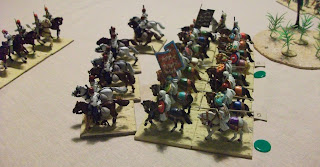A return to the Sudan this week with the action surrounding a mounted column which is returning to the Nile after a fruitless search for the Mahdist leader Mullah Mak-En-Hah who is stirring up trouble for the Imperialists. The Egyptian force had been brought up river on steamers and the infantry brigade deployed to hold the landing at Wadi Yahmeen while the Egyptian mounted column set off into the interior. For over a week the column had been chasing one false lead after the other and now, running low on supplies and ready for a return to barracks they have turned back towards Wadi Yahmeen. For the last two days they have been pursued by an enemy force, but this morning the menacing dust cloud has disappeared. Before them lies the last short stretch of desert before the village and the steamers ready to take them back north.
 |
| Overview of the table. The mounted column arrives at point A |
 |
| The infantry and steamers at Wadi Yahmeen |
The column commander was just about to order the advance when a mass of cavalry suddenly appeared, cresting a small rise to the south east. There was just time to wheel the cavalry to face the threat and also dismount the mounted infantry before the enemy was on them. The sheer impetus of the Dervish attack broke through the first Egyptian cavalry regiment, scattering the few survivors who turned and fled back into the desert. Behind them, the second Egyptian cavalry regiment managed to hold the exultant warriors, but took heavy casualties doing so. On their right, the mounted infantry had attempted to stop the enemy charge with a volley. They failed and were soon fighting for their lives. With casualties rising, the infantry line wavered, stepped back, stepped back again and then broke into knots of desperate men. One by one these were eliminated and then the cavalry swept off into the desert, searching for those who had run away.
 |
| The devastating Dervish cavalry attack |
When the second Egyptian cavalry regiment was assailed by a second unit of Dervish cavalry, the die was cast and they too were driven from the field. The only remaining unit from the column was a unit of Bashi Bazouks who the commander had considered unsuitable for combat against the desert warriors, but useful only for scouting. This unit was only saved from destruction by the need for the Dervish cavalry to rally and reorder after their melees.
In Wadi Yahmeen the Egyptian infantry had been unwilling spectators to the unfolding disaster, now they were to experience the fury of the Dervish attack as masses of enemy infantry swept towards the village. From the north came Beja warriors, from the south Ansar. On the Nile, the steamers tried to move into position to offer supporting fire to the defenders. The more southerly, the Balmoral did manage to disorder the leading wave of Ansar and give the defenders of Wadi Yahmeen time to move into position and try and deter the attackers with firepower.
 |
| The Ansar attack |
As the Ansar attack developed, one body moved against the western face of the village, the other against the southern. The unit defending the southern face of the village had swung to face westwards to meet the attack. This allowed them to fire full volleys at the attackers but it also masked the Ansar from the fire from the Balmoral. In the event, the volleys proved sufficient to stop the leading Ansar unit in its tracks. Seeing the indecision in the enemy ranks, the commanding officer ordered his men to charge and they drove back the Ansar in disorder.
 |
| The southern attack stalls |
The unit on the western face also managed to fire volleys against the incoming attackers, but in doing so they ran low on ammunition. Even worse, they did not inflict sufficient casualties to drive off the attackers. In the ensuing melee both sides took heavy casualties, but the Egyptians were saved by the fact that the leading unit of Ansar had outpaced their supports. When the Ansar were routed the Egyptians were thus granted a short respite before the next attack came in.
 |
| The Beja driven off |
 |
| The Windsor covers the northern edge of the village |
To the south, Mullah Mak-En-Hah had decided to make a personal intervention. Galloping forward he led the second Ansar unit against the Egyptian infantry. Ignoring the final volley from the Egyptians the Ansar crashed into the enemy line. Men fell on all sides, the Mullah urged on his followers, the Egyptian officers ordered their men to stand firm. In the end it was the Egyptians who prevailed. The Mullah fell back with the Ansar anxious to get out of range of the Egyptian rifles.

Thanks, I do like these sort of scenarios.
ReplyDeleteSuperb. I love the unit organization. If I started again with my now rather large BFE collections I would have done 16 figure infantry units in two ranks. Thanks for posting.
ReplyDeleteThank you Norm and Chris for your comments. The scenario was fun to play and it could all have gone terribly wrong for the Egyptian infantry, as it had for their cavalry comrades. Chris, Steve did originally start with individually based figures but it was a bit of a chore moving them so therefore he decided on the 4 bases of 4 figures as the standard size of unit.
ReplyDeleteThe basing looks great. I appreciate the reports of BFEII. I am working on a version for ACW (which is very different, of course). It is developing very nicely. I had started this many years ago but put it aside. My group is now playing it regularly (using Zoom) and it is working very well. The group has a very large ACW collection.
ReplyDelete